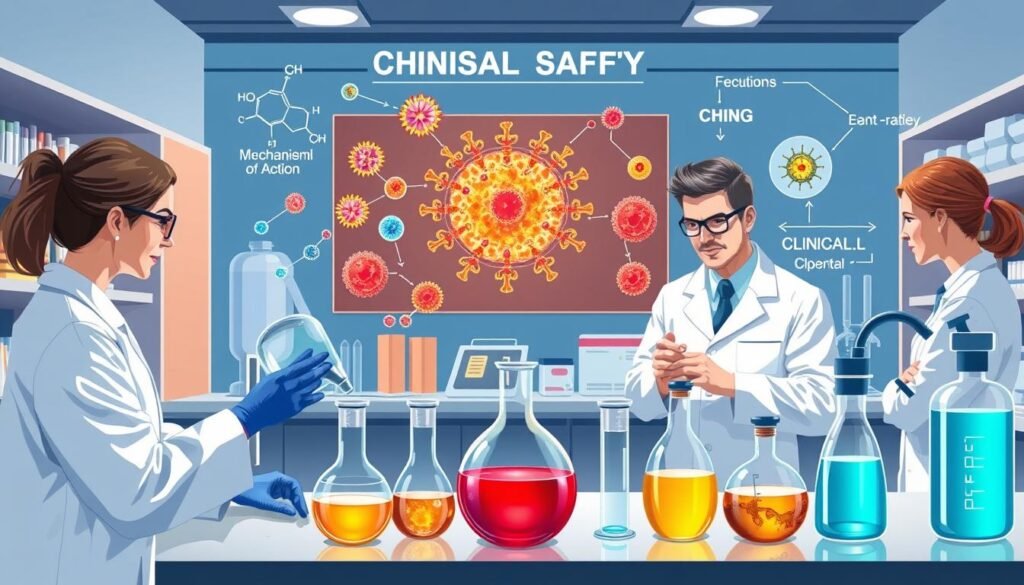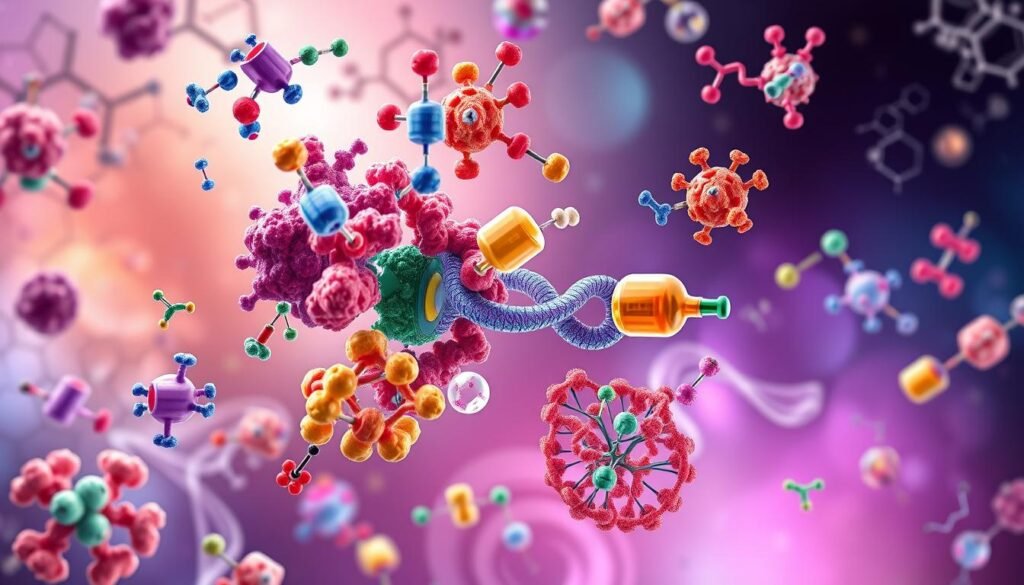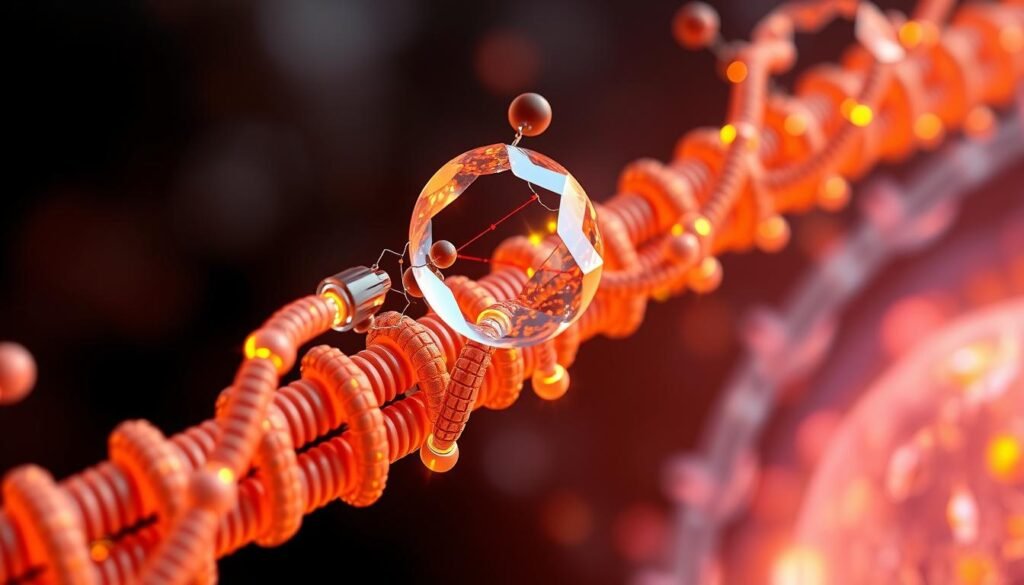Did you know 30% of drugs work well without a known reason? This fact highlights the complexity of drug reactions in our bodies. “Mechanism of action” means the specific ways a drug works to be effective. It’s key in knowing how drugs affect us and in making treatments better.
Understanding this process is essential. Healthcare providers use it to explain treatments to patients clearly. It also helps in making safer and more effective drugs.
Key Takeaways
- The mechanism of action describes how drugs interact at a biochemical level.
- Healthcare professionals frequently refer to mechanisms of action when discussing treatment options with patients.
- Drugs can serve as agonists or antagonists, influencing how they bind to receptors.
- Some medications exhibit multiple mechanisms of action, affecting different receptors simultaneously.
- Understanding drug interactions is crucial for developing personalized treatment plans.
- Identifying the mechanism of action can support drug repurposing for new medical conditions.
What is The Mechanism of Action?
The mechanism of action tells us how a drug works in our bodies. It shows the specific biochemical interactions caused by the drug. This is key for healthcare pros to ensure treatments work well.
Understanding the mechanism and mode of action is crucial, but they are often mixed up. They are similar yet play important roles in medical treatments.
Definition of Mechanism of Action
When we talk about the mechanism of action, we mean how drugs affect cells and molecules. It’s about how a drug finds its target and starts the healing process. Knowing this helps in checking if a drug will work and foreseeing drug interactions.
Difference Between Mechanism of Action and Mode of Action
Mechanism and mode of action are often seen as the same, but they’re different. The mode of action talks about the bigger changes a drug causes in our body. On the other hand, the mechanism focuses more on the tiny molecular details.
This distinction helps in understanding how drugs help us heal. It also helps doctors explain treatments to their patients better.
The Importance of Understanding Mechanisms
Understanding how drugs work is key in creating new medicines. Knowing these mechanisms helps find new treatments and improve existing ones. Researchers explore these areas to learn about possible side effects and interactions. This is vital to keep patients safe during treatment.
Impact on Drug Development
Knowing how drugs work boosts success in developing them. Only 8% of drugs get FDA approval. This fact shows the need for a deep understanding of how therapies work. For example, studying how manual therapy helps with muscle spasms offers valuable insights. This knowledge helps shape the creation of new treatments.
Clinical Safety Implications
Clinical safety is a big concern in medicine. Doctors need to know how drugs work to prescribe them safely. Understanding a drug’s effects and risks leads to better prescribing practices. This protects the health of patients. Some studies show failing to understand this can make treatments fail in trials. This leads to advancing ineffective therapies without proving they are safe or work well.

| Aspect | Impact of Mechanisms |
|---|---|
| Drug Discovery | Enhances identification of novel therapies. |
| Therapeutic Efficacy | Improves understanding of treatment outcomes. |
| Clinical Safety | Promotes safer prescribing practices through knowledge of pathways. |
| Trial Success Rate | Increases chances for regulatory approvals. |
How Drugs Interact at a Molecular Level
Understanding how drugs work together at a molecular level is crucial for their success. It’s about how these drugs connect and impact different biological systems. This knowledge helps in making drugs more effective by looking at key drug targets, like enzymes and receptors.
Biochemical Interactions Within the Body
Drugs start their work in the body by engaging in molecular interactions. This often means attaching to specific receptors and changing biological pathways. For example, around 40 percent of medicines aim for G-protein coupled receptors, a major class of proteins that send signals in cells. Drugs are made to either kickstart or block these signals, affecting our bodily functions.
Types of Molecular Targets: Enzymes and Receptors
Drugs mainly target enzymes and receptors, each playing a critical role. Enzymes can be stopped by drugs, like selective serotonin reuptake inhibitors (SSRIs), to up serotonin in the brain. Receptors are key for drug action sites. Naloxone (Narcan), for example, can counteract opioid overdose by blocking opioid receptors, showing how targeting specific receptors is vital.
It’s important for drugs to hit specific targets for maximum effect. They use physical and chemical traits to bind to cellular receptors. How receptors adapt, like increasing or decreasing in response, affects how well a drug works over time. This can lead to tolerance or severe withdrawal symptoms.
The complex interaction between drug targets like enzymes and receptors is key for creating new medicines. A deep dive into these interactions can lead to better drugs and outcomes for patients. For more details on how targets and drug mechanisms intertwine in drug discovery, check out this article.

Receptor Binding and Its Role
Receptor binding helps us know how drugs work with our bodies. It’s when drugs attach to certain spots, leading to different body reactions. We see two key types of compounds here: agonists and antagonists. They each have a unique way of changing how our bodies work.
Understanding Agonists and Antagonists
Agonists are like the body’s natural helpers, turning on receptors. This can make your heart beat faster or strengthen brain signals. Antagonists, though, block these spots and stop agonists from acting. This is very helpful for treating high blood pressure or anxiety. Balancing these agents is key for the right medical effects.
Receptor Selectivity in Drug Action
Choosing the right receptors is key in medicine for both success and safety. Drugs with high selectivity aim at exact receptors, lessening bad side effects. This knowledge helps in creating better drugs and in treatment plans. For example, certain cancer drugs focus only on specific receptors. This attacks the cancer while keeping healthy cells safe. Selectivity gives better treatment results with fewer harmful effects.

| Type | Mechanism | Examples |
|---|---|---|
| Agonists | Activate receptors | Adrenaline, Morphine |
| Antagonists | Block receptor binding | Atenolol, Naloxone |
| Receptor Selectivity | Target specific receptors | Imatinib (CML treatment), Tamoxifen (breast cancer) |
Exploring Physiological Responses to Drugs
Drugs interact with our bodies in unique ways, leading to different physical responses. This happens through signal transduction pathways, which are key in managing our body’s functions. Studying how drugs affect these pathways helps us understand both their positive effects and side effects.
Signal Transduction Pathways
Signal transduction pathways let cells talk to each other and react to external cues. When a drug attaches to a cell, it starts a series of reactions. This series turns a cellular signal into a response in our bodies. The role of neurotransmitters like dopamine and serotonin in these pathways can greatly influence our mental health and behavior.
For example, an increase in dopamine in the nucleus accumbens is linked to the pleasure we get from certain substances. This shows how physiological responses and the use of drugs are connected.
Impact of Physiological Changes on Health
Understand these changes is vital for good health outcomes. Drugs can tweak important body processes, like heart function and metabolism, by binding to receptors. By targeting these reforms, we can improve how treatments work and reduce unwanted effects. Using systems pharmacology to study these effects helps make drugs safer by foreseeing harmful reactions in our cells.
The complexity of these reactions shows why ongoing research is crucial. Especially when it comes to the safety and efficacy of drugs.
To truly grasp the effects of drug interactions, it’s critical to see how they apply in healthcare and patient safety. More info can be found in this discussion on pharmacodynamics and its real-world impacts.
Case Studies: Mechanism of Action in Common Drugs
Looking into case studies helps us learn how different drugs work, especially antibiotics and SSRIs. This knowledge increases our understanding of their power and guides treatment choices.
Antibiotics: Targeting Bacterial Infections
Antibiotics, like fluconazole, have greatly improved public health. In recent years, however, we’ve seen more resistance to these drugs, making it important to study how they work. Fluconazole has helped over 16 million people, including many with AIDS in the U.S. It attacks certain paths in bacteria and fungi, helping fight infections.
Even though they are effective, the rise in drug resistance is a concern. Research is now focused on finding new, safe, and better drugs for fungal infections. Developing antibiotics is a challenge because we have to fight infections and drug-resistant germs at the same time.
SSRIs and Their Impact on Mental Health
SSRIs are a key step forward in treating mental health issues. They lift serotonin levels in the brain, which helps with mood and emotional stability. They work by keeping more serotonin available in the brain. This helps people with depression and anxiety feel better.
It’s very important for health professionals to help patients choose the right SSRI therapy. They must consider side effects and how much medicine to take. This shows the close connection between medication and mental health. For more details on SSRIs, you can check out this resource.
The Role of Pharmacodynamics in Drug Efficacy
Pharmacodynamics is key to knowing how drugs work in the body. It looks at how drug levels link to their biological impact. This helps judge how well treatments work and keeps them safe.
This knowledge is crucial to see how drugs engage with body pathways.
Understanding Therapeutic Efficacy
Therapeutic efficacy is how well a drug achieves the intended health benefit. Research in pharmacodynamics pinpoints how drug effects take place. For example, people often take about 6.58 drugs in a treatment plan. This can cause roughly 2.68 interactions between the drugs. It shows why it’s important to understand these interactions for better health outcomes.
Measuring Drug Effects on Biological Pathways
Measuring how drugs affect biological pathways is vital in pharmacodynamics. Methods like math models help check different drug combinations or doses. These approaches show how drugs might work together or fight each other, impacting health results. For instance, using multiple drugs has been very effective against diseases like infections, cancer, and heart conditions.
However, challenges remain, like fully understanding action mechanisms and complex system interactions. Identifying these issues helps predict treatment results better and improves treatment plans. For more details, visit this resource.
| Type of Interaction | Description |
|---|---|
| Synergistic | The combined effect of drugs is greater than the sum of their individual effects. |
| Additive | The combined effect of drugs equals the sum of their individual effects. |
| Antagonistic | The combined effect of drugs is less than the sum of their individual effects. |
Exploring Multimodal Mechanisms of Action
In the world of pharmacology, it’s key to know how drugs work in different ways. Drugs aim to interact with many parts of the body to be more effective. This approach helps treat health issues better by using various biological reactions.
Studying these interactions helps us find new ways to develop drugs and treatments.
Multiple Pathways in Treatment Outcomes
Caffeine is a great example of a drug working in many ways. It mainly fights adenosine receptors to make you feel more awake and less tired. But it does more than that.
Caffeine also affects how neurotransmitters are released, helping to improve mood and brain function. It shows the power of using multiple ways to enhance treatments and user experiences.
Caffeine: A Complex Mechanism of Action
Cannabidiol (CBD) also shows how complex these drug actions can be. CBD works on different targets, like G protein-coupled receptor 55 and other channels. This is important for treating conditions like epilepsy.
As research goes on, we aim to find better treatments, especially for diseases like Alzheimer’s. Understanding these actions helps healthcare innovate and create better therapies for people.